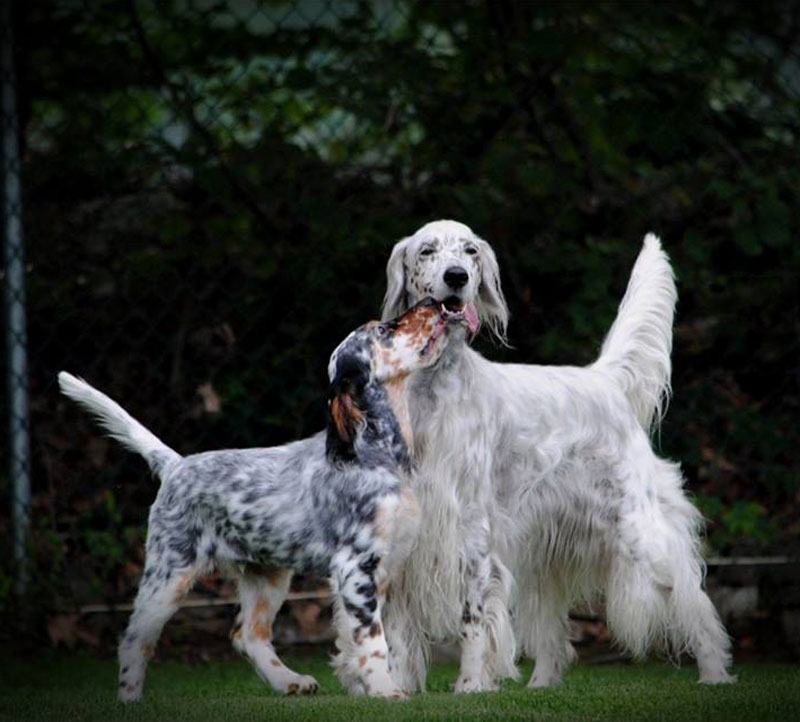Health issues
Ask about hip and elbow dysplasia; also hereditary deafness, which while rare, does sometimes occur. A responsible breeder will be only too pleased to answer these questions, plus provide you with:
- worming and vaccination schedules,
- advice on proper housing, exercise and diet,
- further support.
- English Setters can also be prone to gastric torsion (commonly known as bloat.
Code of Practice – Breeding
As a condition of membership, each member, upon application for admission or renewal of membership of the Club, shall adhere to the following breeding practices:
A member shall breed primarily to improve the breed.
A member shall take responsible action to reduce the incidence of hereditary diseases.
a) Hip Dysplasia
- Hip scores must be obtained prior to breeding.
- Evidence of scores must be provided on request to prospective puppy purchasers.
b) Hereditary Deafness
- Parents must be BAER tested prior to breeding.
- Evidence of test must be provided on request to prospective puppy purchasers.
The Club will refer enquiries to members/breeders and ask that they supply the information as above. It will be seen as a breach of the Code of Practice if members/breeders do not comply. Breaches of the above will be considered a disciplinary matter and will be dealt with by Committee of Management.
The Code of Practice – Breeding became effective from 1 January 2010.
Information on Gastric Torsion
Canine Gastric Torsion is a condition that can occur in dogs. Any dog is susceptible, but especially the deep chested breeds, including all Setter breeds. If not recognized and treated as a veterinary emergency, it is FATAL.
Gastric Torsion is also called BLOAT, and it can advance to GASTRIC DILATION – VOLVULUS (GDV), when the dog’s stomach actually twists and closes itself off at both ends. As a consequence of this twisting (VOLVULUS), gas and liquid are trapped in the stomach which becomes bloated. Immense pressure is exerted on other organs, and if left untreated, will result in an agonizing death.
Any signs of bloat should be investigated, and GDV is a critical situation that can only be treated by veterinary intervention. The sooner you can get an afflicted dog this help, the more hopeful the outcome.
SYMPTOMS include:
Distended stomach, restlessness, panic, obvious distress, frequent attempts at vomiting without success, drooling, pale gums, shallow breathing.
CAUSES include:
Stress, anxiety.
Also, the American College of Veterinary Surgeons states – “Several studies have been published that have evaluated risk factors and causes for gastric dilatation and volvulus in dogs. This syndrome is not completely understood; however, it is known that there is an association in dogs that have a deep chest (increased thoracic height to width ratio), are fed a single large meal once daily, or are older.”
PREVENTATIVE MEASURES include:
Feeding multiple small meals during the day, not one large meal, avoiding stress, elevating feeding bowls, separation from other dogs at meal times so fast eating is reduced, not exercising for at least an hour before or after feeding.
FOR MORE INFORMATION ON BLOAT AND GDV check out this excellent site at https://www.preventivevet.com/dogs/help-my-dogs-stomach-is-bloated-understanding-canine-bloat-torsion-and-gdv
Information on Hip Dysplasia
Almost all breeds suffer from hip dysplasia which is an abnormality of the hip joint, whereby the ball and socket joint of the hip does not fit correctly. Hip dysplasia can cause great pain and also affect mobility. In extreme cases surgery is the only option to relieve the pain.
On the other hand many dogs affected by hip dysplasia show no clinical signs such as lameness or reluctance to move. In fact the way a dog moves is not an indication of the health of its hips.
There are a number of scoring systems for hip dysplasia, however the most commonly used is the BVA/KC (British Veterinary Association and Kennel Club) which is the system generally used by the Australian Veterinary Association.
The breed average score for the English Setter on the AVA/ANKC Breed Average listing for 2014 was 15.9. It is pleasing so see the breed mean and median scores reduce over the last 5 years, and as at 2019 the breed average statistics for English Setters recorded a Mean score of 13.5 and a median score of 11 as per the BVA. (British Veterinary Association) https://www.bva.co.uk/media/3438/chs-hips-summary-2005-2019.pdf
The Median Score is lower than the average (or mean), so scores should be even better for animals to be bred with than those with the Mean score, meaning that the recommendation is that English Setters with scores no higher than the Mean 13.5 should be bred with, and preferably the Median of 11.0, as the lower the score the better for the future health of the breed’s hips.
What is Hip Dysplasia
Hip dysplasia is a deformity of the hip joint that occurs during a dog’s growth period. The ball of the femur does not fit properly into the hip socket. Some dysplastic dogs show absolutely no signs of this condition, whilst others may be severely affected. With increasing age arthritis can develop in affected dogs.
Signs of Hip Dysplasia may include any of the following symptoms:
- Hind leg lameness
- Lack of coordination in the hind quarters (swaying and staggering)
- Reluctance to run and jump
- Difficulty when attempting to lie down or stand up
- Abnormal gait.
However, accurate diagnosis can only be made by a veterinarian who will need to x-ray the hips. The lower the score for each hip, and the combined total score, the healthier the hips are. Further information can be obtained from links below.
http://www.vetwest.com.au/pet-library/hip-dysplasia-in-dogs
and
http://www.veterinarypartner.com/Content.plx?P=A&A=1916&S=1&SourceID=42}Veterinarypartner.com
Club policy on Hip Dysplasia
The English Setter Association of Victoria Inc. supports the Australian Veterinary Association’s position that all breeding stock be hip x-rayed and only those animals with scores below the breed average should be bred. The ESAV has developed a Code of Practice-Breeding to which members must adhere. Both the sire and dam of a litter must be x-rayed for Hip Dysplasia and the results made available to puppy purchasers. Infringements are reportable and will result in disciplinary action from the Committee of Management.
Inherited Deafness
Inherited deafness is recognized in white coated breeds. In some breeds the percentage of affected animals is high. It is not a common condition in English Setters but it does occur.
There is now an accurate diagnostic test available to breeders and owners known as the *BAER Hearing Test.
Responsible breeders will ensure that the sire and dam of a litter are tested and their puppies also.
It is a requirement of the ESAV through the club’s a Code of Practice-Breeding , that litters sold via the club have been BAER hearing tested and results are available to puppy purchasers. Failure of members to comply is reportable and will result in disciplinary action by the Committee of Management.
*BAER … The hearing test known as the brainstem auditory evoked response …
- The University of Sydney gives an overview of congenital deafness and the BAER testing procedure: https://www.uvths.com.au/baer-testing/
- For residents of Victoria testing is available at Ballarat https://www.bvp.com.au/companion-animal-clinic-services.php






Contact Us
Main Contacts
Secretary 0432 400 029 englishsettervic.secretary@gmail.com
President 0432 787 029 englishsettervic.president@gmail.com
Treasurer 0407 563 554 englishsettervic.treasurer@gmail.com
Litter Service 0432 400 029
Or send a message via the form on the right.
We will get back to you as soon as possible.


